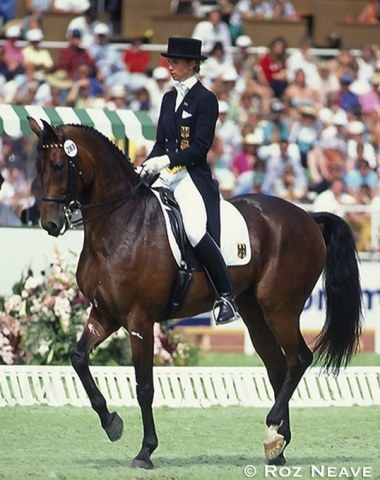
- Text by Silke Rottermann for Eurodressage
- Photos © Elisabeth Weiland, Hugo Czerny, Dirk Caremans, PSV Photo - NO REPRODUCTION ALLOWED
When Nicole Uphoff fell off a young horse at home two months before the World Championships and broke her left arm in three places, it seemed more than uncertain if her magnificent Westfalian gelding Rembrandt would be able to also add the World title to his impressive winning streak that started at the 1988 Olympic Games in Seoul. He prevailed and captured the Triple Crown - Olympic, European, and World Champion - at these first ever World Equestrian Games.
A team effort in which German national coach Harry Boldt trained the cheeky four-legged artist for Nicole made it possible that the German dream pair could enter the venerable Olympic stadium of Stockholm through its impressive archway.
First World Equestrian Games
The 7th dressage World championships took place from 24 July till 5 August 1990 and were held in the Swedish capital of Stockholm. They were the first according to a concept which younger readers might not have known any differently, as the World Equestrian Games (WEG).
The idea arose around the mid 1980s under the FEI regency of HRH Prince Philipp. The World Equestrian Games had to bring the three Olympic disciplines, endurance as well as vaulting and driving all together in a common World championships.
As attractive as this idea sounded, as complicated and highly challenging it was to put it into (successful) practice, overall from a financially profitable point of view. The first which dared this enterprise was Stockholm, having won the bid against Lisbon and Rome. In hindsight these first WEG were perhaps the most successful ones, apart from profitable Aachen 2006.
Swedes Set the Bar High
With the impressive historical Olympic stadium of 1912 as the centre of the Games, the Swedes managed to have the other competition venues as well as the stables in (almost) walking distance. Their excellent organization owed to the fact that ever since they got the first WEG assigned, they hosted the „Stockholm International Horse Show“ as well as an international eventing competition as test-event in preparation of the actual Games.
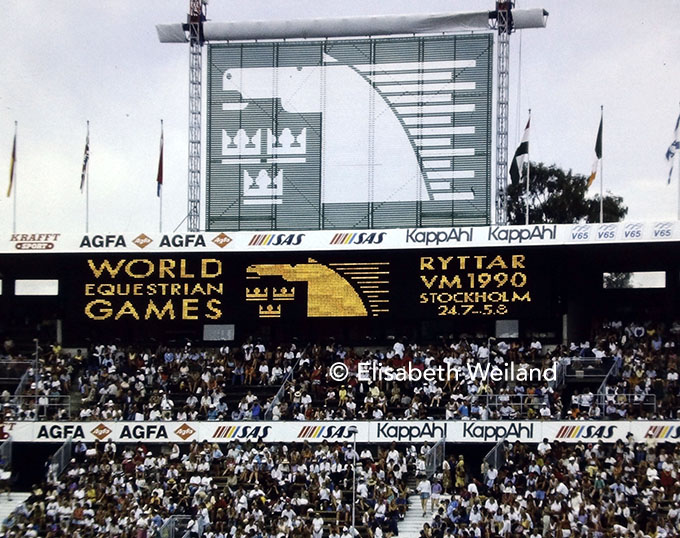
In standard with the occasion, the Swedes organized a brilliant opening ceremony in the Olympic stadium in which 88 years earlier equestrian sports debuted on the Olympic stage under the guidance of Swedish Count Clarence van Rosen. However, the celebrations on that first day somehow reminded of 1956 when Stockholm organized the equestrian Olympic Games because quarantine regulations back then were too strict to allow them to happen in Melbourne.
Under the eyes of several royal highnesses, not in the least the Swedish royal family, the Games were opened by Swedish king Carl Gustaf XVI.
Although the opening ceremony happened under an overcast sky, the rest of the Games profited from brilliant Swedish sunshine and a big support from the spectators, which created a unique atmosphere.
Dressage Becomes a Global Affair
Fitting to the size of the whole event, dressage at WEG in Stockholm had the largest field in the history of dressage competitions until then: 68 riders from 22 different nations, of which 15 fielded a complete team of 4, started in the Grand Prix which of course was spread out over two days.
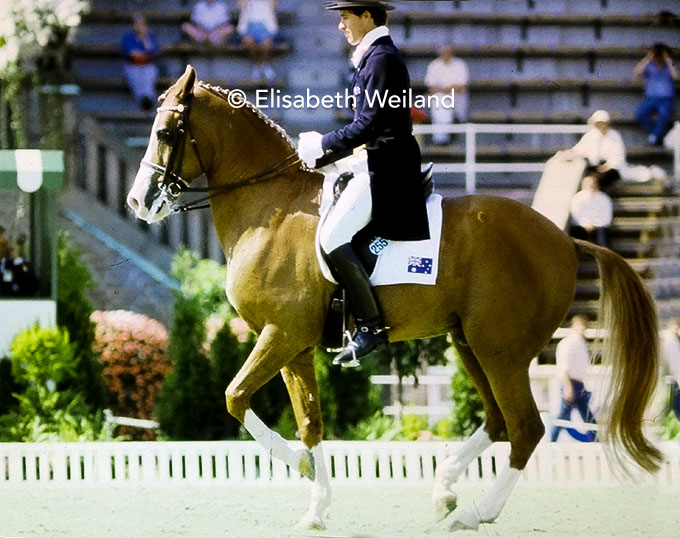
were part of the first ever Aussie team at an international
dressage championships. He relocated to Germany
afterwards.
The sport was undoubtedly growing and becoming really global at that time. Just ten years earlier, at the 1980 Olympic Festival in Goodwood, for example, the first individual rider from Australia took part— in Stockholm the Aussies were able to send their first ever team.
From Stockholm on, the sport grew further with a record number of 100 riders contesting 24 years later at the WEG in Caen, until today the record.
But not everybody was entirely happy about this development 30 years ago. German O-judge, the late Heinz Schütte, who judged no less than three Olympic Games and five World Championships, expressed his concerns in Reiter Revue’s report about the 1990 WEG. He confirmed back then that the enlarged field of participants resembled the FEI's goal to spread dressage globally, but warned that quantity might replace quality. He recommended introducing qualifying scores for the discipline of dressage, which did not exist back then. Schütte also saw a deterioration in quality as the intention existed to shorten the Grand Prix test more and more, a trend that started with deletion of the „schaukel“ movement (double rein-back) in the 1980s.
The Contenders
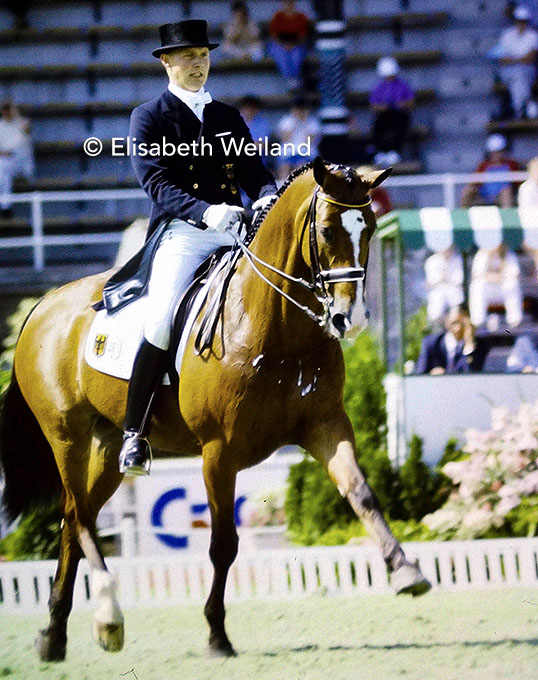
The Soviet Union, medalless since their bronze at the 1978 World Champs, were on a certain rise since Seoul 1988 with Switzerland and Sweden enlarging the circle of possible medal contenders.
1988 Olympic bronze medalist Canada had no horse from Seoul on their team, only Ashley Munro (née Nicoll, now Holzer) stayed on the team, but with a new horse.
Individually the game seemed quite open. It remained uncertain how the highly sensitive and fine tuned Rembrandt would react to Nicole Uphoff riding him with a cuff over her broken arm. Corlandus had been injured earlier in the season, Matador had been out after surgeries, just as Gauguin de Lully CH, whose rider had sustained a horrific back injury after a fall from a young horse at home, right after the 1989 World Cup final.
Ganimedes was a secret medal contender, 4th at the previous Europeans, and at age 12 in his prime and with a quality of gaits which were well ahead of his time.
Grand Prix / Team Competition
After rain and an overcast sky during the opening ceremony, gleaming sunshine accompanied the three days of dressage in the impressive Olympic stadium with its two towers of which the clock was striking every 15 minutes.
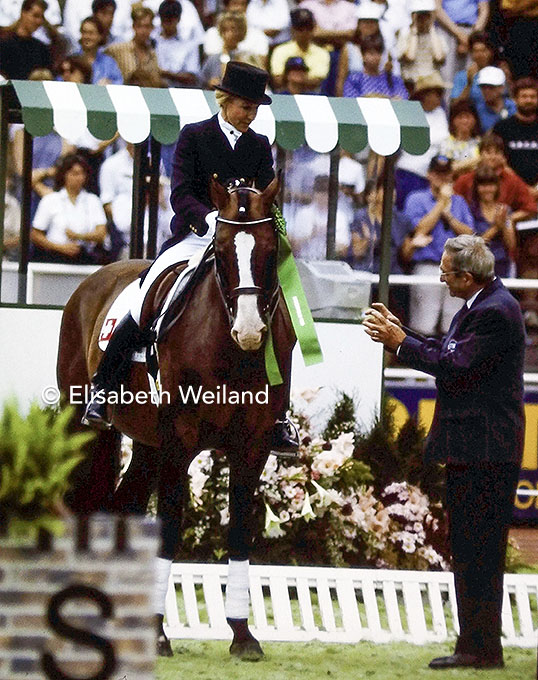
The ground jury included William Hamilton, a 1964 Olympic rider for Sweden, Elena Kondratieva from the Soviet Union, Heinz Schütte from Germany, Eizo Osaka from Japan, and chief judge Wolfgang Niggli from Switzerland. They had the demanding job of separating the wheat from the chaff and on top of it had to judge a wider variety of horse types than a judges' panel later in history.
Everybody was holding the breath when Rembrandt entered the sun lit stadium, posing the question if his genius would take the upper hand to his sometimes exuberant temperament. The leggy Westfalian, clearly influenced by his grandsire on his dam’s side, Angelo xx, left not a second of a doubt that he continued where he left at the Europeans in Mondorf les Bains a year earlier. He appeared even stronger, more athletic, and seemed fully aware that the stage was set for him and him alone.
Nobody, who didn’t know, would have noticed that Nicole Uphoff rode with her left arm in a cuff to stabilize the broken arm. Rembrandt combined lightness with athleticism and an enchanting expression. That he was to win the Grand Prix was no question. The 13-year-old gelding was the only horse to come over the 1500 point barrier, scoring a whopping 1549 points for the German team.
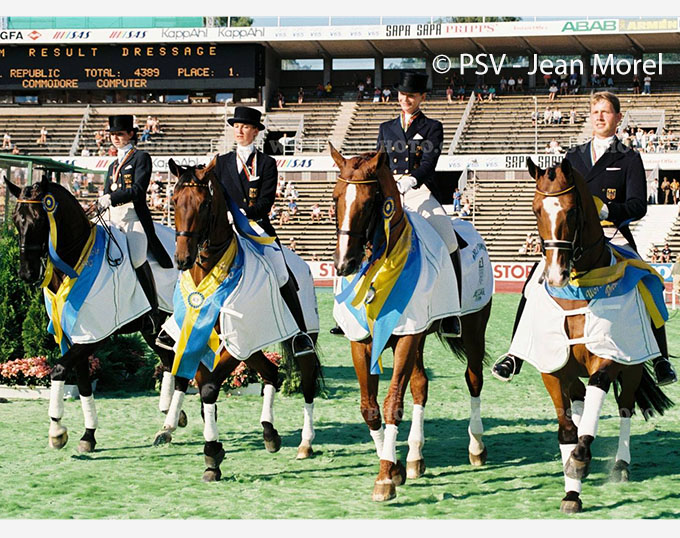
Rothenberger (Photo © PSV - Jean Morel)
Sven Rothenberger, who was a very successful Young Rider, came right behind Theodorescu. He was in the lucky position to have had two experienced championship horses at his disposal for Stockholm: The 13-year-old Danish gelding Andiamo (by May Sherif), a previous Olympic horse of Swiss Otto Hofer, and the 15-year old Dutch bred Ideaal, who was a gold and bronze medalist with Johann Hinnemann at the previous World Championships in 1986. In the end the German team played safe by relying on the Doruto-son. Rothenberger had an impressive championship debut with no major faults and finished 6th.
Fourth German team member, but this time drop score was Ann-Kathrin Kroth (now again Linsenhoff) whose monumental former Celle state stud stallion Golfstrom was the four-legged debutant on the German team. They came 9th, but had the bad luck that at that time only three riders per nation were allowed to take part in the Grand Prix Special which in Stockholm, like in Seoul before, saw 18 pairs.
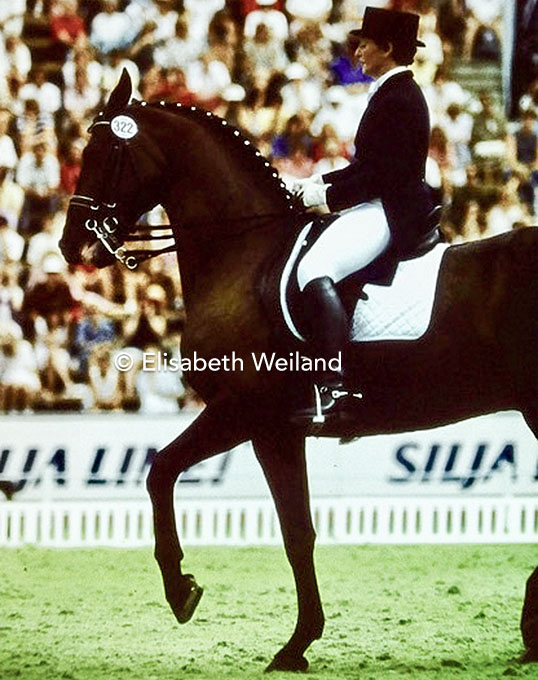
The Grand Prix of Stockholm was also one of several comeback kids. Apart from Nicole Uphoff who had just two months without being in the saddle, Switzerland’s former World Champion Christine Stückelberger and Kyra Kyrklund’s magnificent Danish stallion Matador missed out on the previous year for extremely serious injuries.
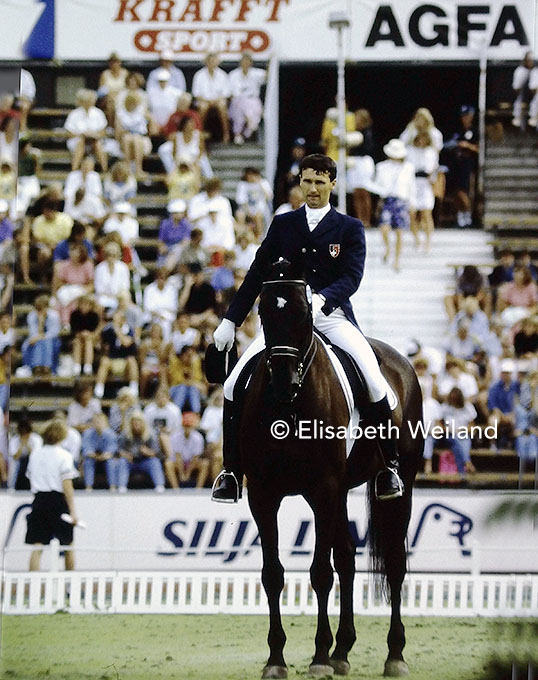
The home team of Sweden, which had never won a World Championships team medal before, narrowly missed out in front of their home crowd, but their 4th place was more than respectable. Over all given the fact that their long-time and highly respected national coach Walter Christensen was too sick to take care of their preparations and died shortly after the Games. This was especially a burden for Christensen’s personal long-time student and the team’s strongest rider, Louise Nathhorst who rode the immensely talented, but relatively inexperienced gelding Dante into the Grand Prix Special. Narrowly missing it by one place was Liane Wachtmeister with her handsome blonde liver chestnut gelding Elixir who had failed the vet check in first attempt, but came back strongly for the best Grand Prix of his career.
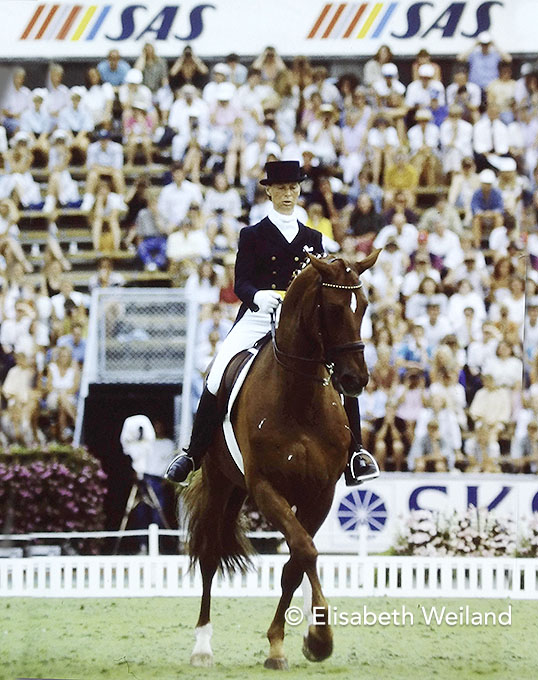
The biggest surprise of the Grand Prix was Matador with Kyra Kyrklund. Always considered a world horse, the black stallion with the charming forelock, the black spots in his blaze, and white legs was twice operated, first for severe colic caused by a twisted intestine and then for an inguinal hernia. There was an eruption of the inner muscle wall a few weeks after the colic surgery, and Matador had to undergo another risky surgery in Sweden to have the muscles closed with a net. His comeback seemed rather unrealistic, but in Stockholm only a visible scar at his tummy reminded the public that this crowd-favourite had been close to death about 12 months before. Just ten points less than Gauguin de Lully, Matador placed 3rd and got the warmest welcome of all horses, also owed to the popularity his rider enjoys in Sweden.
Just two points behind was Margit Otto-Crépin’s imposing Holsteiner Corlandus in fourth place. Certainly one of the most impressive dressage horses in the history of the sport, the 1987 European champion could still fight for a medal.
Whereas Canada was at the bottom of the field int he team ranking this time, the Australian newcomers surprisingly came 13th. They did not have the best, but without a doubt the most interesting team of horses: A thoroughbred, a typey Anglo Arab, a Thoroughbred / Stockhorse / Quarterhorse crossbred, and a German warmblood. It proved that dressage is there for every horse, only that nowadays not every horse can be successful.
Grand Prix Special / Individual Competition
A total 18 riders and horses were allowed to contest for individual glory, amongst them title defender Anne-Grete Törnblad (formerly Jensen) with Marzog’s successor Supermax Ravel, an elegant dark bay horse but with no chance of a medal.
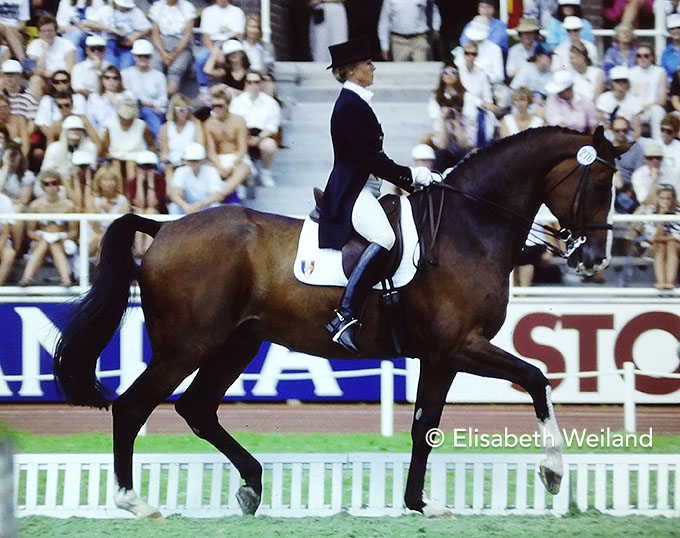
The three riders from the Soviet Union ended in 7th, 9th and 14th position with Nina Menkova and Dikson being their best, as expected. Their elegant horses thrived in the Grand Prix Special programme, but in comparison to the top horses lacked the quality of basic gaits to place higher.
Whereas young Carl Hester had almost made it to the European Championships for young riders at the end of the 1980s, German born Italian Pia Laus won silver there (at the time riding for Germany) with a horse her mother bought as an unbroken youngster for the inexperienced teenage daughter. Ignorance is often bliss and Pia and her Rhinelander liver chestnut stallion Adrett moved on from Young Riders to seniors, now for her father’s nation Italy. Stockholm was their first (of numerous) senior championships and their 10th place was truly a remarkable feat for the student of the late Dr. Uwe Schulten-Baumer senior, who stayed a true amateur rider her entire career.
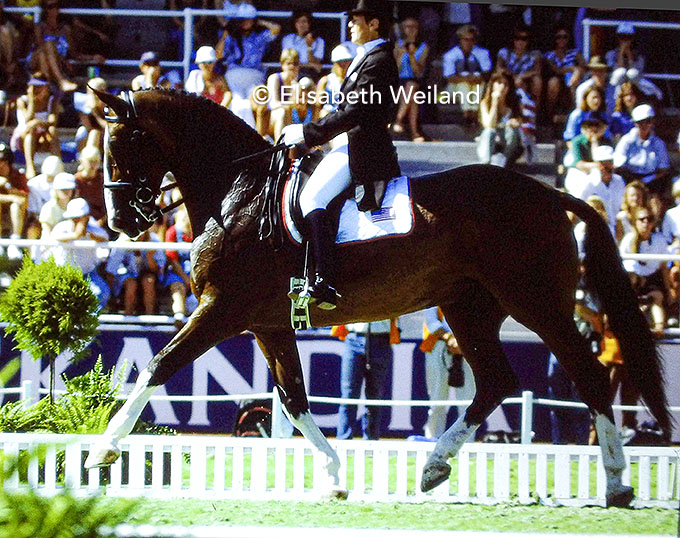
Swedish anchor Louise Nathhorst had chosen to show her younger horse Dante over the more experienced Swedish stallion Chirac at the WEG and the risk certainly paid. The sensitive chestnut had won three international Grand Prix classes prior to Stockholm and was ready to step up the big time. German judge Heinz Schütte even placed him 4th, but the overall score meant Dante was holding on to his 8th place from the Grand Prix. Just like Gifted, Dante’s time was yet to come.
The battle for the medals was opened by Sven Rothenberger on the 1986 bronze medalist Ideaal. The young German showed the experienced horse to the best of its abilities and finished an excellent 6th in the end.
The Grand Prix text that Gauguin de Lully produced in Stockholm was called "his best ever Grand Prix“ by the late Dr. Reiner Klimke as well as by Heinz Schütte, so expectations were very high for the Swiss pair to repeat their impressive performance and defend their 1986 silver medal. It was not to be though; mistakes in the flying changes made the score drop and Christine Stückelberger placed 5th in the end.

This nose-length ahead of him was Monica Theodorescu’s Ganimedes whose ability to develop impulsion and take it into collection like the passage were simply breathtaking. The bronze achieved of Stockholm became the Westfalian gelding’s only individual medal because as soon his stable-mate Grunox took over, Ganimedes continued a star of the World Cup circuit, winning the final repeatedly.

Rembrandt, just like in the Grand Prix, was untouchable. The 13-year-old formed a unity with his rider which sent shivers down the spine of the onlookers. From a technical point of view, his piaffes, for example, were still not sitting, but those details seemed dispensable once one was spellbound by the freedom, the elegance, and power with which he celebrated a program as difficult as a Grand Prix Special. Nicole Uphoff once said of Rembrandt that sometimes she only had to think and he did. At least it looked like he was doing it on his own accord in Stockholm and in this way followed in the hoof-prints of his predecessor Marzog.
Breeding at the 1990 World Championships
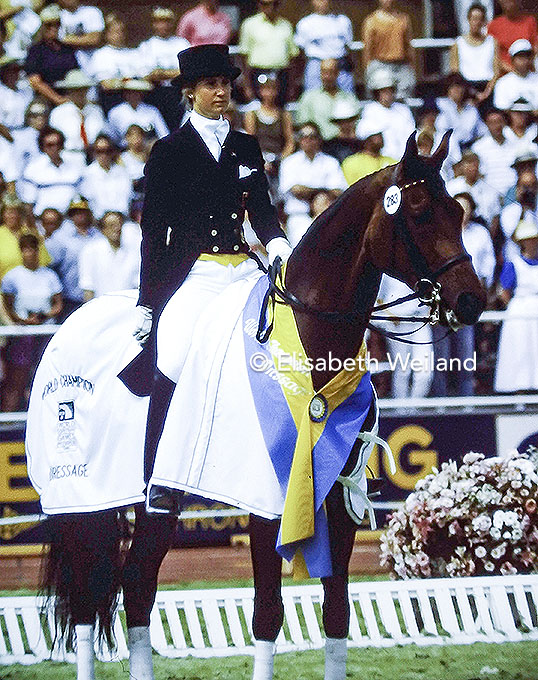
Detailed informations to most of the horses, like breed, year of birth, gender and pedigree can be found in the result list of the Stockholm Grand Prix.
By Silke Rottermann for Eurodressage.com
Photos - FEI History Hub - Hugo Czerny - Elisabeth Weiland
Related Links - World Championships Series
1986 World Championships Cedar Valley - Marzog Reconfirms Supremacy
1986 World Championships Cedar Valley Through the Eyes of Anne-Grete Jensen
1982 World Championships Lausanne — Again Dr. Reiner Klimke
1982 World Championships Lausanne Through the Eyes of Nicky Kelly and Claudia Rosner
1978 World Championships in Goodwood - Dressage in the Park
1978 World Championships Goodwood Through the Eyes of Christine Stuckelberger
1974 World Championships in Copenhagen: The Most Picturesque World Championships
1974 World Championships Copenhagen Through The Eyes of Ruth Klimke
1970 World Championships in Aachen: Soviet Union Defeats Germany
1970 World Championships Aachen Through The Eyes Of Ulla Hakanson
Finally Official - The First Dressage World Championships 1966
1966 World Championships Berne Through The Eyes Of…
References
Swedish Equestrian Federation, Ryttar - VM - World Equestrian Games 1990, Stockholm 1990, p. 6-9, 12-35.
Elke Müller-Mees, Nicole Uphoff - Traumkarriere im Sattel, Franck-Kosmos Verlag, Stuttgart 1992, p. 28-30.
Dr. Reiner Klimke / Deutsche Reiterliche Vereinigung, Olympia der Reiter Seoul 1988, FN-Verlag Warendorf / Landwirtschaftsverlag Münster Hiltrup 1988, p. 155.
Dr. Reiner Klimke / Werner Ernst / Deutsche Reiterliche Vereinigung, Olympia der Reiter Barcelona 1992, FN-Verlag Warendorf / Landwirtschaftsverlag Münster-Hiltrup 1992, p.29 - 31 / 159.
Rembrandts Konkurrenten, in: Reiter Revue 9/1990, p. 16 / 17.
https://dressagetoday.com/lifestyle/one-on-one-interview-with-robert-dover/ (29th July 2022)
https://www.knytkalaset.com/nyhet/Artikelserie-Min-Häst-Historia-Liane-Wachtmeister (29th July 2022)
https://yourdressage.org/2019/04/04/american-dressage-legends-gifted/ (8th July 2022)